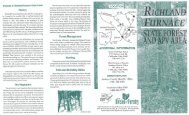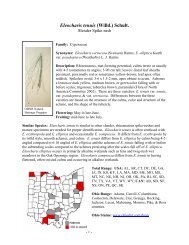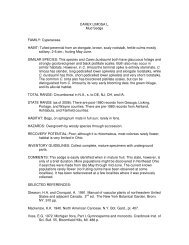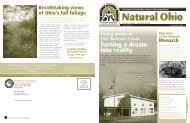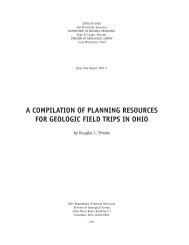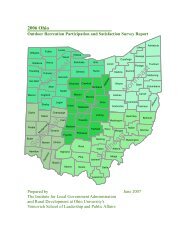Owls of Ohio - Ohio Department of Natural Resources
Owls of Ohio - Ohio Department of Natural Resources
Owls of Ohio - Ohio Department of Natural Resources
You also want an ePaper? Increase the reach of your titles
YUMPU automatically turns print PDFs into web optimized ePapers that Google loves.
giving the impression <strong>of</strong> a giant moth. The common name is accurate; thevery short ear tufts are hard to see, and an observer will only notice them ona clearly seen perched owl.Northern harriers, which frequent the same habitats, can look similar whenperched on the ground with only the head and upper body visible. These hawkshave facial discs similar to owls, but their heads appear smaller, they lack darkeye patches and ear tufts, and do not have pale V-shaped “eyebrows.”Long-eared owls, the strictly nocturnal counterpart to the short-ear, look verysimilar in flight and when flushed are sometimes misidentified as this species. Theupper wings <strong>of</strong> long-eareds are grayer, the buff-colored patch near the end <strong>of</strong> thewings is less prominent, and they are more heavily streaked below.O h i o S tat u s short-eared owlOccurs primarily as a migrant and winter visitor. Often actively migrates duringthe day, and birds can appear nearly anywhere, even in urban sites. Winter numbersvary greatly from year to year and site to site, depending on food availability. Shortearedowls are very opportunistic and they can concentrate in large groups at localesexperiencing peak small mammal populations. In 1999, at least 80 were present atthe Wilds, a large reclaimed surface-mined area in Muskingum County. The nextyear, only a few were there. This type <strong>of</strong> annual fluctuation is very typical in <strong>Ohio</strong>.Breeding short-ears have never been common in <strong>Ohio</strong>; our state is at the extremesouthern periphery <strong>of</strong> their range. Most nesting records probably coincide withspikes in small mammal populations. However, documented nestings are very rare,and some summering individuals are probably unmated non-breeders.Hab itat short-eared owlStrictly open habitats; short-eared owls even roost on the ground in fields,only rarely choosing conifer groves for roosting. They prefer large fields,grasslands, marshes, and sometimes the grassy areas <strong>of</strong> airports. In recentyears, an increasing number <strong>of</strong> owls are being found in the massive tracts <strong>of</strong>open grassland resulting from reclamation <strong>of</strong> former coal surface mines insoutheastern <strong>Ohio</strong>. There have been several breeding records in these sites,and in general, the numbers <strong>of</strong> wintering owls seems to be increasing.Day old short-eared owls in nest.Good short-eared owl habitat; massivereclaimed surface mine grasslands. Thisarea, at the Wilds, sometimes supports largenumbers <strong>of</strong> wintering owls, and severalpairs have also nested here.Photo by: ©E.T. Jones / VIREOPhoto by: ODNR Division <strong>of</strong> Wildlife / Jim McCormac



